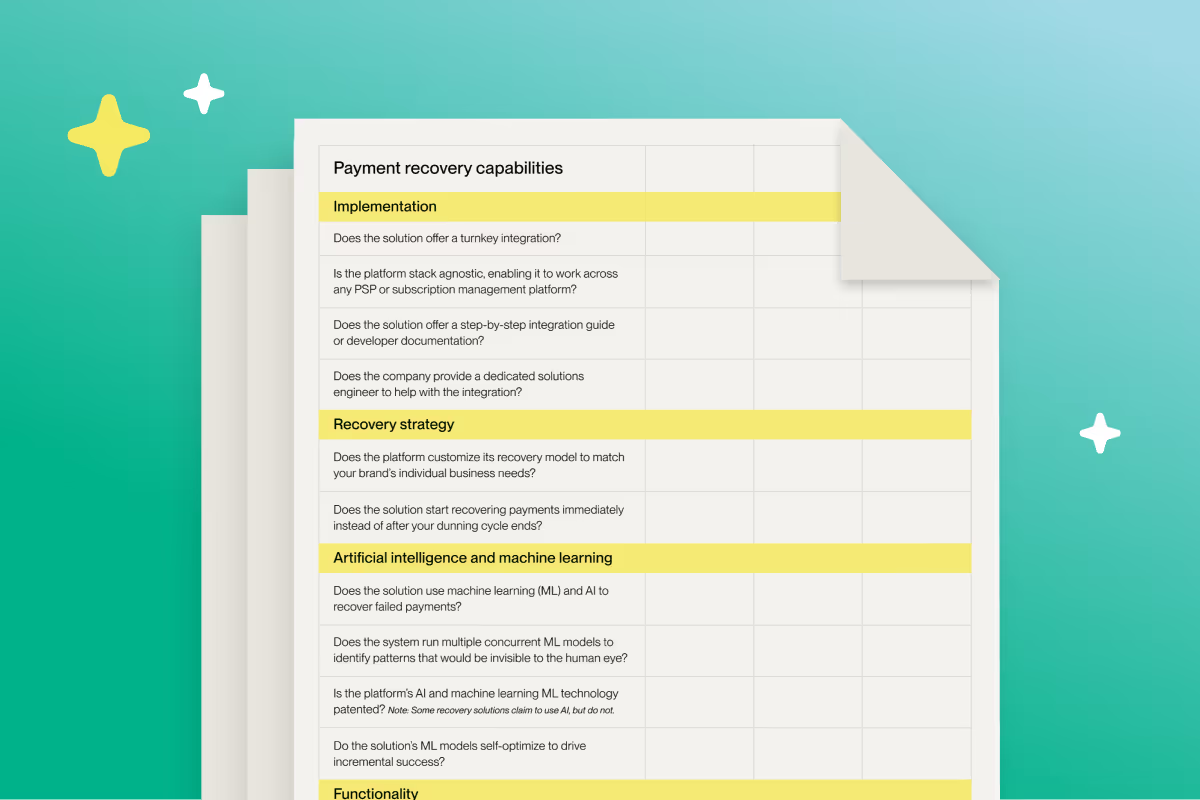
Evaluation: 10 questions to ask your next payment recovery solution
Rising acquisition costs, shifting consumer habits, and economic headwinds have forced subscription-based brands to reassess their business strategies and intensify their focus on improving retention.
While there are many ways to keep subscribers enrolled, including delivering an excellent customer experience, the most efficient and effective strategy is to reduce involuntary churn caused by failed payments—which can account for as much as 50% of overall churn.
To help you get started, we’ve compiled the top questions you should ask a payment recovery solution before partnering with them.
1. How does your recovery solution measure success?
The goal of this question is to determine the specific metrics the recovery platform uses to gauge success and how they calculate their measurements, i.e., their definitions. This is imperative because you want to ensure your business and the platform speak the same language and that the platform’s definitions accurately reflect their effectiveness.
A common issue with out-of-the-box recovery solutions (like those offered by payment service providers) is that they remove decline codes they consider “non-retriable” from their success calculations. This inflates the perceived recovery rate and minimizes potential revenue leakage.
Two metrics your recovery solution should track (but probably doesn’t) are the transaction authorization rate (TAR) and invoice success rate (ISR). Knowing your authorization rate and success rate allows you to assess the impact of your retry program and align with your business needs.
Invoice Success Rate
[IN-voice suh-CESS rayt]
ISA measures how many invoices were successful on the first payment attempt.
If your TAR and ISR are low, you’re likely being too aggressive with your retries, which can harm your overall payment health. Conversely, if your TAR and ISR are abnormally high, you should be more aggressive with your retries.
It’s best to consider recovered revenue, payments health, TAR, ISR, as well as additional data points such as payments fees and dispute rates as optimization levers. There's no one-size-fits-all retry strategy, so you’ll need to determine what is best for your business.
2. What is your integration process like?
You want to determine if the platform can integrate with your payment stack, how it integrates, the resources required to complete the project, and how long it will take to start your proposed retry program.
There are 3 integrations to be aware of:
- Turnkey: A pre-built, ready-to-use solution. The benefits include little to no development time, out-of-the-box functionality (and playbooks), and fast deployment, allowing you to start recovering more revenue in weeks or sometimes even days.
- Hybrid: A mixed approach that combines both standardized and custom features. A hybrid integration may take longer to implement than a turnkey integration, but it allows for more customization.
- Custom: Many large brands have bespoke subscription management tools and payment stacks, as well as unique data or logic requirements that necessitate a one-of-a-kind integration. While custom integrations can be completed quickly, they typically take months to finish. When evaluating solutions for custom integrations, ask for examples, case studies, reference calls, and how long it typically takes to launch.
The bottom line is that you want a solution that can handle your business's unique needs.
Build vs buy: The truth about payment recovery solutions
3. How does your integration interact with my payments stack?
When discussing an integration, it’s crucial to determine how it works within your payments stack. Failed payments are complex, and retry solutions employ various approaches to recovering revenue, some of which are more effective than others.
Two popular approaches are automated payment recovery and direct customer communication.
Automated recovery attempts to recover failed payments without customer intervention. For example, these solutions will retry payments at different times or with slightly different data until the transaction is successful. On the other hand, some solutions interact with customers directly by sending emails.
While you can recover revenue with both approaches, automatic recovery is the most effective, especially when paired with machine learning technology that analyzes historical data and customer behavior to develop tailored retry strategies.
4. How will your solution scale with my business?
Payments are not static. New technologies and financial regulations require recovery solutions to continually evolve to better serve their customers. What you want to determine is how the solution you're evaluating does this and the steps it plans to take to improve over time.
Ask about the solution’s product roadmap and new features that are in the pipeline. As your business grows, you want to ensure your retry solutions can handle multiple payment service providers, cross-border transactions, and new payment methods.
Payments are not static. New technologies and financial regulations require recovery solutions to continually evolve to better serve their customers.
For instance, Butter recently launched Dynamic Dunning, a feature that enables merchants to tailor the dunning length of an invoice based on attributes such as subscription type, transaction amount, geography, and more.
5. What visibility and reporting do you offer?
A quality payment solution will provide reporting on recovery and overall payments health metrics, which will allow you to make more informed payment decisions. In particular, you can use the data to tweak both acquisition and retention.
We covered two of these metrics earlier in the guide, but we will go into more detail here. When selecting a partner, double-check that they report the following data:
- Revenue Recovery Rate (RRR): This measures the percentage of failed revenue that has been recovered. Tracking RRR over time provides insights into a platform's direct contribution to revenue retention.
- Invoice Recovery Rate (IRR): IRR tracks the percentage of failed invoices that were successfully recovered. Monitoring IRR reveals how effective a solution is at rescuing individual invoices and improving customer retention.
- Return on Investment (ROI): This assesses the financial impact of a solution in terms of the value recovered relative to the investment made. ROI quantifies the tangible benefits of using a payment recovery solution, demonstrating how the increased revenue aligns with overall business goals.
Overall payments health
- Transaction Authorization Rate (TAR): TAR measures the success rate of transaction authorizations, revealing patterns in authorization declines and approvals. You should be able to segment this metric by BIN. Decreasing failed payments can have a positive impact on TAR.
- Invoice Success Rate (ISR): This measures the overall success rate of invoices from initial attempts through retries, helping identify trends and gaps in invoice resolution.
6. How often do you test and optimize retry logic and messaging?
Your payment recovery solution should continuously optimize their retry logic. Unfortunately, many out-of-the-box solutions have adopted a set-it-and-forget-it approach.
The reason why one-size-fits-all solutions have failed to perfect their recovery solutions is multifaceted, but typically comes down to difficulty and lack of focus. Retry optimization requires analyzing vast amounts of transaction data, which is challenging without the aid of machine learning algorithms. And, in some instances, a platform’s retry solution is just one of many features and not a core competency.
Butter is dedicated to payment recovery and utilizes patented machine-learning algorithms to drive growth for our clients. Armed with cutting-edge technology, our solution parses large amounts of payment data and detects patterns that are invisible to human observation. We then implement custom retry strategies for each category of failed payment.
More importantly, Butter’s machine learning models self-optimize as transaction data and business inputs change over time.
7. What security and compliance standards do you meet?
Payment recovery solutions should adhere to strict security and compliance standards due to the sensitive nature of the data they handle (including financial and personal information). We’ve outlined the most crucial compliance standards below.
Payment Card Industry Data Security Standard (PCI DSS)
PCI SSC is a global forum that develops security standards for account data protection. The group categorizes businesses and service providers into different levels based on their annual transaction volume and size. If you are an enterprise business, partner with a solution that has PCI SSC Level 1 compliance.
In layman's terms, Level 1 compliance means the solution doesn’t store sensitive payment data directly, and instead leverages secure tokenization.
System and Organizations Control (SOC)
SOC is a voluntary compliance standard developed by the American Institute of CPAs. To achieve compliance, an accountant examines a company’s controls around the security, availability, and confidentiality of customer data. Recovery solutions should have a Type II certification, indicating controls and processes have been evaluated over an extended period of time, typically between 3 and 12 months.
Privacy regulations
Your recovery partner should demonstrate full compliance with major privacy frameworks, including the General Data Protection Regulation (GDPR), the California Consumer Privacy Act (CCPA), and other regional data protection laws.
In short, your recovery partner must implement proper data subject rights, maintain detailed privacy policies, and ensure all customer communications include appropriate opt-out mechanisms and consent management.
Infrastructure security
Look for a solution built on secure cloud infrastructure with regular penetration testing, vulnerability assessments, and 24/7 security monitoring. The platform should maintain detailed audit logs, implement role-based access controls, and provide transparent incident response procedures.
8. What’s your pricing model—and how aligned are you with our success?
Every failed payment solution prices its services differently. The most advantageous pricing model is an ROI guarantee or a revenue share on all recovered revenue. An ROI guarantee demonstrates confidence in a platform’s capabilities, while a revenue share model ensures the platform must work as advertised, creating a win-win scenario for both parties.
9. What type of customer support can we expect?
From onboarding to troubleshooting, you want to work with a payment recovery platform that prioritizes customer support. Ask about monthly and quarterly strategy review sessions and for examples of when the platform proactively approached a customer with an idea on how to help them generate more recurring revenue.
10. How do you utilize AI and machine learning?
“A lot of businesses say they use AI, but when you press them, it becomes obvious they’re just using it as a buzzword.”
We’re in the middle of an AI hype cycle. Everyone claims to use AI, but only a few businesses actually do. Before signing with a retry platform, ensure they can clearly articulate how they use AI and machine learning to drive results. Otherwise, you’ll pay a premium for what amounts to marketing.
When discussing machine learning and AI, ask the vendor’s team members about their technical capabilities. Case in point, 82% of Butter’s team operates in technical roles, while 35% are machine learning experts and data scientists.
Alexander Sokolov, senior director of software engineering at Athena Club, said it best:
“Nowadays, a lot of businesses say they use AI, but when you press them, it becomes obvious they’re just using it as a buzzword. The fact that Butter actually uses AI and can easily explain how they use it to reduce failed payments sets them apart.”







